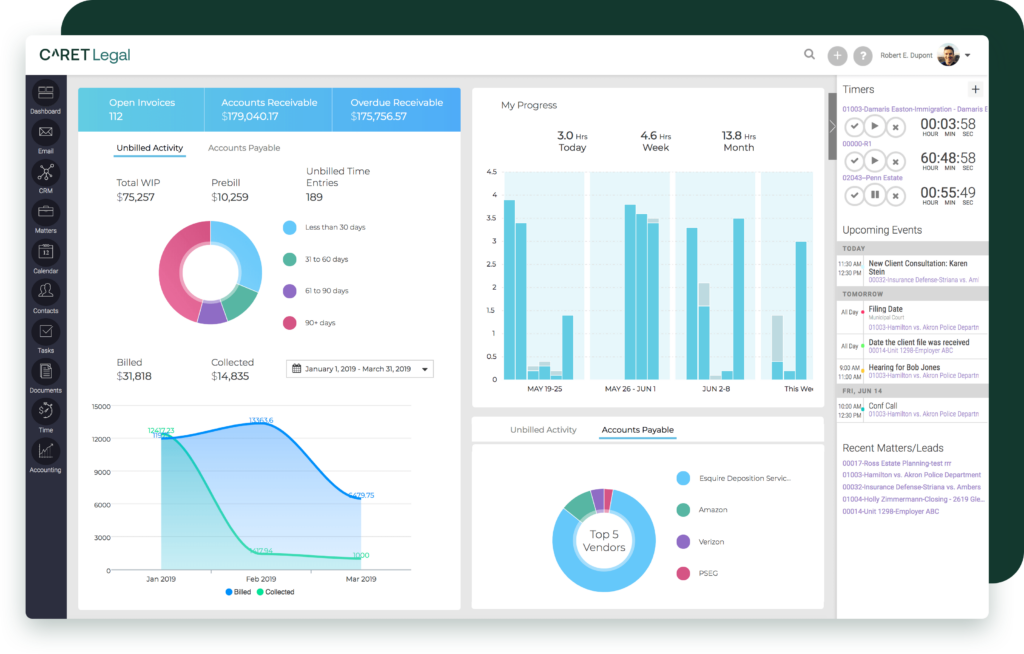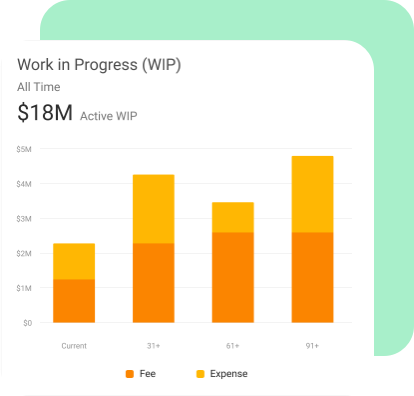A law firm KPI dashboard is one of the most useful ways small to medium-sized firms can monitor success and assess whether goals are being met.
Running a successful law firm demands insight into key performance indicators (KPIs) that reflect the health and growth of the business. Law firm KPI dashboards are an invaluable tool for tracking and managing the metrics that matter most. With a clear view of KPIs, small firms can monitor success in real time and ensure their goals are being met, empowering them to make data-driven decisions that drive sustainable growth.
What are law firm performance metrics and how do they benefit you?
Law firm performance metrics are used to evaluate specific goals and aspects of your firm’s success. By tracking KPIs, you obtain valuable data that provides insight into how your firm is functioning and whether your performance is meeting your expectations across specific areas.
What are law firm performance metrics and how do they benefit you?
Law firm KPIs, or key performance indicators, are metrics used to evaluate specific goals and aspects of your firm’s success. By tracking KPIs, you obtain valuable data that provides insight into how your firm is functioning and whether your performance is meeting your expectations across specific areas.

Admin dashboard within CARET Legal
Every KPI you set and track should meet three basic criteria:
- It should reflect your firm’s strategy and goals.
- It must be critical to your firm’s overall success.
- It needs to be quantifiable so it can be monitored and tracked.
When you tailor your KPIs to the unique goals you have for your firm, you’re able to answer critical questions about how your firm is performing and make informed decisions that ultimately improve major drivers like firm revenue and growth. Tracking attorney performance metrics also allows you to adjust and adapt as the legal landscape continues to shift.
What metrics belong on your law firm’s KPI dashboard?
Tools like CARET Legal offers a comprehensive library of pre-built reports for clients, compensation, productivity, accounting, trust, and vendors, all designed to support your firm’s growth. Many firms start by creating KPI dashboards that answer specific questions you have, like:
- What is the average client acquisition rate?
- How effectively are we managing resources?
- What does our current cash flow look like?
- What’s the breakdown of fees versus expenses per case?

Making sure you’re at least meeting minimum goals in these areas will go a long way toward positioning your firm for success. If you find out that you’re underperforming anywhere, you can quickly address the problem and put yourself on the right path going forward.
1. Client satisfaction:
It’s relatively simple to gather client feedback using a web survey or telephone interview. Set up a survey site, and include the link to your email signature, or send an invitation to each client when an active matter closes.
2. Client development:
Client development is essentially business development: the methods by which a firm attracts prospective clients and manages ongoing relationships with existing clients. Track your win rate – of 100 initial contacts, how many become clients? For ongoing clients, set and track specific targets for new work from existing clients.
A few good areas to focus on at the start are client acquisition rates and satisfaction, firm productivity and utilization, and firm cash flows.
3. Cost of client acquisition (CAC):
Simply put, expenses related to acquiring new clients – marketing, advertising, sponsorships, events, and the cost of your time in billable hours – are the cost of acquisition. Divide one month’s acquisition cost by the number of new clients won in the month, to determine the CAC per client. Your target for the cost of client acquisition depends on the type of law and the return on investment per client; some become long-term retainer relationships, and others are clients for a single case only. Legal case management software can help you keep track of this metric.
4. Attorney realization rates:
Are attorneys maximizing revenue from billable work? Realization is a measure of how much time an attorney records in comparison with the fees that are collected. Realization is expressed as a percentage; fees are recorded and divided by fees collected.
5. Law firm profitability:
To remain profitable, revenues must of course exceed costs. To calculate your firm’s net profit margin, determine your total revenues for a financial period (typically a calendar quarter or year). From that, subtract all operating expenses, including payroll, office expenses, software, and IT services, marketing, and travel expenses.
Once you’ve mastered your initial tracking group, you can start tracking more KPIs in a number of other important areas, including profitability, marketing, client development, individual employee and attorney performance, and firm culture.
Advanced reporting and analytics
For certain pricing plans, firms can utilize CARET Analytics, a powerful tool that creates insightful reports and dashboards so firms can identify trends, track financial performance, and monitor productivity. CARET Analytics provides real-time updates and visualizations that display critical information and reveal bottlenecks in your workflows. Whether evaluating cases, tracking performance, or conducting audits and compliance checks, CARET Analytics can help legal professionals easily understand their data and take more informed and strategic actions.
You’ve got your KPIs, now what?
Once you’re clear on which KPIs you plan to monitor, you need to consider how and when you plan to monitor them, and what you’re going to do with the data that’s generated. You should be setting a regular schedule for evaluating your KPIs, ideally on a monthly basis.
Legal practice management software makes KPI tracking easy
Your ability to easily set goals and report on your firm’s KPIs is largely dependent on your legal practice management software. The right legal technology can help with KPI tracking and do the heavy lifting for you, so you can continue to focus on what you do best – practicing law. It’s important to remember that your KPIs might change over time. What is most crucial for you to track today might not be the case down the road as your firm grows and the world continues to change.
Reporting and KPIs dashboard within CARET Legal
A note on role-based dashboards
Using the right tools to track KPIs will help you be more agile and able to shift your tracking strategy to meet changing demands. When evaluating a practice management system, look for tools or reports that can handle the performance metrics that matter to you.
A variety of dashboard metrics and graphs let you monitor your KPIs and track your progress toward your goals. The best dashboards are role-based (customized) and can include:
- A daily agenda with reminders, calls, and meetings
- An accounting overview showing WIP, payments, AR, and AR aging, to alert you to areas that need attention
- Tracking income and expenses year-to-date or for any time period
You know your firm better than anyone else. When you set KPIs around the things that make your firm uniquely great and get actionable data-driven reporting, you’ll be in the best possible position to know that you’re succeeding as a business and giving your clients the level of service they deserve.
